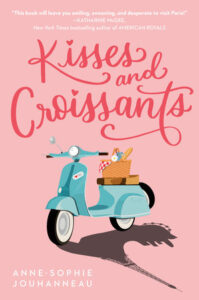 Anne-Sophie Jouhanneau is a French YA writer who skipped across the publishing pond to share her latest novel, Kisses and Croissants. It’s about an American ballet student named Mia who’s given entry into a prestigious Parisian ballet camp for the summer. While there, she meets a cute, friendly boy named Louis. Just when it seems she’s about to have the best summer ever, she finds out Louis is her dance teacher’s son–and off limits. Will Mia become the dancer she’s always wanted to be and get the guy? I recommend reading to find out! I loved being swept away by this enjoyable young adult romance.
Anne-Sophie Jouhanneau is a French YA writer who skipped across the publishing pond to share her latest novel, Kisses and Croissants. It’s about an American ballet student named Mia who’s given entry into a prestigious Parisian ballet camp for the summer. While there, she meets a cute, friendly boy named Louis. Just when it seems she’s about to have the best summer ever, she finds out Louis is her dance teacher’s son–and off limits. Will Mia become the dancer she’s always wanted to be and get the guy? I recommend reading to find out! I loved being swept away by this enjoyable young adult romance.
Mary Sullivan: Hi! I loved your book, Kisses and Croissants. It was so pleasant, fast-paced, and wonderful! Thank you for answering a few questions for Book Club Babble.
Anne-Sophie Jouhanneau: Hello, and thank you so much for the kind words. I’m happy to be here.
MS: The novel takes place in Paris, which seemed like a character itself. I read that you’re from France, but can you share more about why you set the novel in Paris and how you made the setting come to life?
ASJ: I had always wanted to write a love story set in Paris, and it felt like the perfect place for a novel about a ballerina, with a family mystery surrounding an Edgar Degas painting. I grew up just outside Paris, so I know the city pretty well, but I also went there on a research trip in 2017, when there was an exhibition of Degas’s work at the Musée d’Orsay. I made lists of locations and specific things about Paris that I wanted to include, and then figured out where they would best go in the story.
MS: Mia is a ballerina. The descriptions of her time at the ballet school and all of the dance moves felt true. What inspired and informed your decision to write about ballet?
ASJ: I loved the juxtaposition of the artistry of ballet and the beauty of Paris. Both are so romantic and ethereal. The more I looked into it, the more connections I discovered: the Degas paintings, the fact that there are two operas in Paris, that all the ballet terms are French, etc.
In terms of research, I spoke to dancers, watched ballet documentaries and movies, read nonfiction books, and browsed through endless videos on YouTube, both of dance sequences and testimonies of dancers. I was also lucky that a couple of people on my editor’s team were ballet dancers. They helped with getting the descriptions right and shared fascinating details.
MS: Mia’s mother is the one family member who is not overly encouraging of her daughter’s dreams of being a ballerina. It’s hard for Mia because she is so dedicated to her craft. Why was it important to you to add this family dynamic to the book?
ASJ: It’s a theme I’m interested in and that I think fits perfectly in YA literature: how do our upbringings affect how our dreams are shaped, and how we go about pursuing them? Part of what fuels Mia is the belief that the women in her family have all been destined to become ballerinas. She doesn’t learn until the end of the book what that meant for her mother, growing up. It’s a little easier to be completely dedicated to your dream when you haven’t faced too many disappointments yet.
MS: Mia shares a dorm room with a girl named Audrey, who she knows from the States. Audrey is almost like a robot–she’s all ballet, all the time. They have a rivalry, but they also respect each other. Still, their personalities are completely different. Mia is delightful and excitable (though also very dedicated) while Audrey is uptight and guarded. Can you talk about the dynamic between these two girls? I’d love to hear more about why you used these contrasts and maybe what you were looking to explore when it comes to competition and relationships.
ASJ: In this book, I tried to challenge some of the stereotypes you often find in stories about ballet. I wanted my female characters to have a positive attitude toward food and eating, and for their relationships to be nuanced, and not your classic mean-girl rivalry.
Going back to my previous point, while Mia and Audrey are both as passionate about pursuing ballet as a career, their upbringings have been quite different. Audrey has always felt this pressure on her, and it’s really shaped her, whereas Mia has repeatedly been told that it’s okay if she doesn’t make it as a ballerina. From the moment they arrive in Paris, they take different paths. Mia gets swept up in the beauty of the city and Audrey remains focused on the task at hand. But, like most things in life, the best way is somewhere in the middle, and the girls come to learn that they need each other to make the most of their Paris experience.
MS: There is a legend in Mia’s family that her ancestor, a ballerina, was painted by the famed artist Degas. The story and his work is almost like a talisman for Mia–she believes that if she can confirm the story, it will be proof positive that her fate is to be a professional dancer. I liked this part of the story, but I’m curious about your view on the role superstitions play in highly competitive worlds like dance or sports. Or, is this just a quirk of Mia’s?
ASJ: I think a lot of creative types and athletes are either superstitious or really value the power of a ritual, whether it’s a specific song they need to listen to before a performance or the meal they’ll eat. For Mia, it also has to do with the fact that her mother has not been very supportive. She has felt the need to hang on to something else as she pursues her “impossible dream.” Ballet can be an all-consuming passion—especially if you want to become a professional—and one way Mia deals with that is by believing that it is meant to be.
MS: Finally, many of our readers are also writers. How did you come to write young adult novels?
Over a decade ago, I connected with an editor at Fleurus, a large French publisher. She was looking for an author to write a guide to fashion for teen girls. Fashion is a big passion of mine and I loved writing that book. I ended up working with the editor on many more nonfiction books for teen girls, on a variety of topics. Writing young adult fiction was a natural transition. There’s something very special about all the “firsts” that happen in our teen years and it makes for fascinating stories.
Kisses and Croissants is available now wherever you buy books!


